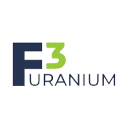F3 Uranium Commences 3,000-Metre Drill Programme at Tetra Zone
.jpg)
F3 Uranium initiates autumn drilling campaign targeting uranium mineralisation at recently discovered Tetra Zone on Broach Lake Property.
- F3 Uranium Corp. has commenced a 3,000-metre diamond drilling programme at the Tetra Zone on its wholly owned Broach Lake Property in Saskatchewan's Athabasca Basin.
- The programme follows previous results from hole PLN25-205, which intersected 1.0 metre grading 2.50% U3O8 within a 22.5-metre mineralised interval averaging 0.26% U3O8, and hole PLN25-217, which encountered 67.0 metres of composite anomalous radioactivity including 49.0 metres of continuous radioactivity.
- Ground electromagnetic surveying has been completed, with 3D inversions in progress to support regional drill targeting along strike.
- The Tetra Zone exhibits weaker conductivity associated with less resistive rocks in a structural damage zone, differing from many basement-hosted uranium deposits in the area.
- The Patterson Lake North Project comprises 42,961 hectares located near Paladin's Triple R and NexGen Energy's Arrow deposits.
F3 Uranium Corp. (TSXV: FUU) is a uranium exploration company operating three properties in the western Athabasca Basin: Patterson Lake North, Minto, and Broach. The company's focus includes the JR Zone and the Tetra Zone, discovered 13 kilometres south of the JR Zone on the Broach Property. The Patterson Lake North Project spans 42,961 hectares in proximity to Paladin's Triple R and NexGen Energy's Arrow deposits. All three properties are accessible via Provincial Highway 955.
3,000-Metre Autumn Drill Programme at Tetra Zone
F3 Uranium has initiated a 3,000-metre diamond drilling programme at the Tetra Zone, located on the company's wholly owned Broach Lake Property. The programme is designed to test the extent of uranium mineralisation identified in previous drilling. The focus will be at deposit scale, with initial drilling stepping out from the high-grade mineralisation in PLN25-205 and the radioactive intervals in PLN25-217.
The Tetra Zone displays different characteristics compared to many basement-hosted uranium deposits in the region. According to the company, the zone exhibits weaker conductivity associated with less resistive rocks within a structural damage zone. These geophysical responses differ from typical conductivity patterns observed in other deposits in the area.
Sam Hartmann, Vice President Exploration, stated:
"We are excited to resume drilling at Tetra now that ground geophysics has been completed, and plan to focus this autumn drill programme at a deposit scale on the Tetra Zone, initially stepping out from high grade mineralisation as in PLN25-205 and the significant intervals of radioactivity in PLN25-217."
Previous Results and Current Drilling Targets
The autumn drilling programme builds on results from two holes drilled earlier this year. Hole PLN25-205 returned a 1.0-metre interval containing 2.50% U3O8 within a broader 22.5-metre mineralised zone averaging 0.26% U3O8. The company classifies uranium mineralisation with assay results greater than 1.0 weight % U3O8 as high-grade.
Hole PLN25-217 intersected 67.0 metres of composite anomalous radioactivity, including 49.0 metres of continuous radioactivity. The company measures natural gamma radiation in drill core using a handheld spectrometer, designating readings exceeding 300 counts per second as anomalous and readings above 10,000 counts per second as highly radioactive. However, spectrometer measurements do not consistently correlate with uranium grades and serve as preliminary indicators of radioactive materials.
The current programme will test mineralisation extent through step-out drilling around these initial holes. All depth measurements reported are down-hole, and true thicknesses have not yet been determined. The drilling aims to establish continuity of the mineralised system identified in the initial discovery holes.
Ground EM Survey and Regional Targeting
F3 has completed ground electromagnetic surveying across the Broach Lake Property. The company is processing 3D inversions of the EM data, which will be incorporated into the targeting model for regional drill site selection along strike from the Tetra Zone.
The geophysical work provides data on subsurface conductivity patterns across the property. Sam Hartmann noted that the unique geological setting of the Tetra Zone is reflected in the geophysical responses, where weaker conductivity is associated with the structural damage zone hosting the mineralisation. This information will assist in identifying potential drill targets with similar characteristics.
The 3D inversion results, once completed, will be integrated with existing geological data to refine the company's exploration model. The Broach Property comprises 19,022 hectares, with the Tetra Zone representing the newest discovery on the Patterson Lake North Project, which also includes the JR Zone located 23 kilometres northwest of Paladin's Triple R deposit.
Next Steps
The 3,000-metre drilling programme is currently underway at the Tetra Zone, with results to be released as assays are received and interpreted. Completion of 3D inversions from the ground EM survey will provide additional targets for potential drilling along the mineralised trend. The programme represents the company's continued exploration of the Tetra Zone discovery announced in August 2025, with drilling focused on testing mineralisation extent from the initial high-grade and radioactive intervals.
Analyst's Notes




Subscribe to Our Channel
Stay Informed













